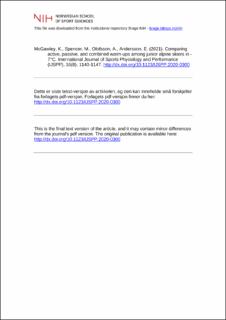| dc.contributor.author | McGawley, Kerry | |
| dc.contributor.author | Spencer, Matthew | |
| dc.contributor.author | Olofsson, Anna | |
| dc.contributor.author | Andersson, Erik | |
| dc.date.accessioned | 2022-03-04T09:14:56Z | |
| dc.date.available | 2022-03-04T09:14:56Z | |
| dc.date.created | 2021-09-01T08:32:31Z | |
| dc.date.issued | 2021 | |
| dc.identifier.citation | International Journal of Sports Physiology and Performance (IJSPP). 2021, 16(8), 1140-1147. | en_US |
| dc.identifier.issn | 1555-0265 | |
| dc.identifier.uri | https://hdl.handle.net/11250/2983021 | |
| dc.description | I Brage finner du siste tekst-versjon av artikkelen, og den kan inneholde ubetydelige forskjeller fra forlagets pdf-versjon. Forlagets pdf-versjon finner du på www.humankinetics.com / In Brage you'll find the final text version of the article, and it may contain insignificant differences from the journal's pdf version. The original publication is available at www.humankinetics.com | en_US |
| dc.description.abstract | Context: Warming up in very cold climates and maintaining an elevated body temperature prior to a race is challenging for snow-sport athletes. Purpose: To investigate the effects of active (ACT), passive (PAS), and a combination of ACT and PAS (COM) warm-ups on maximal physical performance in a subzero environment among snow-sport athletes. Methods: Ten junior alpine skiers completed 3 experimental trials in −7.2 (0.2)°C. The ACT involved 5 minutes of moderate cycling, 3 × 15-second accelerations, a 6-second sprint, 5 countermovement jumps (CMJs), and a 10-minute passive transition phase, while in PAS, participants wore a lower-body heated garment for 24 minutes. In COM, participants completed the active warm-up, then wore the heated garment during the transition phase. Two maximal CMJs and a 90-second maximal isokinetic cycling test followed the warm-up. Results: CMJ performance was likely (P =.150) and very likely (P =.013) greater in ACT and COM, respectively, versus PAS. Average power output during the cycling test was likely (P =.074) greater in ACT and COM versus PAS. Participants felt likely to almost certainly warmer (P <.01) and more comfortable (P =.161) during ACT and COM versus PAS. In addition, participants felt likely warmer (P =.136) and very likely more comfortable (P =.161) in COM versus ACT. Conclusions: COM resulted in significantly improved CMJ performance versus PAS while both ACT and COM led to likely improved 90-second cycling performance. Participants felt significantly warmer during ACT and COM versus PAS and likely warmer in COM versus ACT. Therefore, a combined warm-up is recommended for alpine skiers performing in subzero temperatures. | en_US |
| dc.language.iso | eng | en_US |
| dc.subject | sportswear | en_US |
| dc.subject | heat | en_US |
| dc.subject | exercise tests | en_US |
| dc.subject | clinical trials | en_US |
| dc.subject | athletes | en_US |
| dc.subject | exercise physiology | en_US |
| dc.subject | snow | en_US |
| dc.subject | comparative studies | en_US |
| dc.subject | cycling | en_US |
| dc.subject | body movement | en_US |
| dc.subject | descriptive statistics | en_US |
| dc.subject | jumping | en_US |
| dc.subject | biomechanics | en_US |
| dc.subject | cold temperature | en_US |
| dc.subject | skiing | en_US |
| dc.subject | warmup | en_US |
| dc.subject | sprinting | en_US |
| dc.title | Comparing active, passive, and combined warm-ups among junior alpine skiers in -7°C | en_US |
| dc.type | Peer reviewed | en_US |
| dc.type | Journal article | en_US |
| dc.description.version | acceptedVersion | en_US |
| dc.source.pagenumber | 1140-1147 | en_US |
| dc.source.volume | 16 | en_US |
| dc.source.journal | International Journal of Sports Physiology and Performance (IJSPP) | en_US |
| dc.source.issue | 8 | en_US |
| dc.identifier.doi | 10.1123/IJSPP.2020-0300 | |
| dc.identifier.cristin | 1930290 | |
| dc.description.localcode | Institutt for fysisk prestasjonsevne / Department of Physical Performance | en_US |
| cristin.ispublished | true | |
| cristin.fulltext | postprint | |
| cristin.qualitycode | 1 | |
